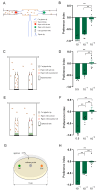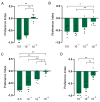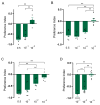Deterrent Effects of Clary Sage Oil and Two Major Constituents against Drosophila suzukii (Diptera: Drosophilidae)
- PMID: 39452309
- PMCID: PMC11509010
- DOI: 10.3390/insects15100733
Deterrent Effects of Clary Sage Oil and Two Major Constituents against Drosophila suzukii (Diptera: Drosophilidae)
Abstract
Drosophila suzukii (Diptera: Drosophilidae), spotted-wing drosophila, poses a significant threat to soft-skinned fruit crops in the Americas, Europe, Africa, and Oceania, as well as in Asia. The application of chemical insecticides is the primary control strategy for D. suzukii; however, resistance has developed with the indiscriminate use of chemical insecticides. Essential oils, considered potential alternatives to pesticidal strategies, exhibit potent toxic and sublethal behavioral effects against numerous pests, including D. suzukii. Clary sage oil repels a variety of agricultural and household pests; however, whether it has a repellent effect against D. suzukii remains unknown. Here, we found that clary sage oil exhibited dose-dependent repellency against D. suzukii adults in a T-maze assay, a two-choice assay and a two-choice attraction assay. Also, clary sage oil showed a significant repellent effect against D. suzukii larvae. Next, we explored the chemical constituents of clary sage oil by GC-MS and identified two major constituents, linalyl acetate (40.03%) and linalool (23.02%). Furthermore, the behavioral assays of linalyl acetate and linalool showed that both compounds conferred comparable repellency against D. suzukii adults and larvae. Finally, we found clary sage oil, linalyl acetate, and linalool elicited EAG responses in D. suzukii, especially clary sage oil, suggesting the repellency was mediated by the olfactory system. These findings indicate that D. suzukii shows olfactory-based behavioral avoidance of clary sage oil, linalyl acetate, and linalool. Clary sage oil and its major constituents may be possible alternatives in the management of D. suzukii.
Keywords: EAG; clary sage oil; linalool; linalyl acetate; repellency; spotted-wing drosophila.
Conflict of interest statement
The authors declare no conflicts of interest.
Figures




Similar articles
-
Repellent, oviposition-deterrent, and insecticidal activity of the fungal pathogen Colletotrichum fioriniae on Drosophila suzukii (Diptera: Drosophilidae) in highbush blueberries.Sci Rep. 2020 Sep 2;10(1):14467. doi: 10.1038/s41598-020-71341-y. Sci Rep. 2020. PMID: 32879373 Free PMC article.
-
Insecticidal Activity of Selected Essential Oils against Drosophila suzukii (Diptera: Drosophilidae).Plants (Basel). 2023 Oct 30;12(21):3727. doi: 10.3390/plants12213727. Plants (Basel). 2023. PMID: 37960084 Free PMC article.
-
Two volatiles from anthracnose-infected blueberries trigger electrophysiological and aversive behavioral responses in Drosophila suzukii (Diptera: Drosophilidae).J Econ Entomol. 2025 Feb 19:toaf032. doi: 10.1093/jee/toaf032. Online ahead of print. J Econ Entomol. 2025. PMID: 39970055
-
Drosophila suzukii in Southern Neotropical Region: Current Status and Future Perspectives.Neotrop Entomol. 2017 Dec;46(6):591-605. doi: 10.1007/s13744-017-0554-7. Epub 2017 Aug 30. Neotrop Entomol. 2017. PMID: 28852987 Review.
-
Advances in the Chemical Ecology of the Spotted Wing Drosophila (Drosophila suzukii) and its Applications.J Chem Ecol. 2018 Oct;44(10):922-939. doi: 10.1007/s10886-018-1000-y. Epub 2018 Jul 27. J Chem Ecol. 2018. PMID: 30054769 Review.
References
-
- Asplen M.K., Anfora G., Biondi A., Choi D.-S., Chu D., Daane K.M., Gibert P., Gutierrenz A.P., Hoelmer K.A., Hutchison W.D., et al. Invasion biology of spotted wing Drosophila (Drosophila suzukii): A global perspective and future priorities. J. Pest. Sci. 2015;88:469–494. doi: 10.1007/s10340-015-0681-z. - DOI
-
- Dam D., Molitor D., Beyer M. Natural compounds for controlling Drosophila suzukii. A review. Agron. Sustain. Dev. 2019;39:53. doi: 10.1007/s13593-019-0593-z. - DOI
-
- Tait G., Mermer S., Stockton D., Lee J., Avosani S., Abrieux A., Anfora G., Beers E., Biondi A., Burrack H., et al. Drosophila suzukii (Diptera: Drosophilidae): A Decade of Research Towards a Sustainable Integrated Pest Management Program. J. Econ. Entomol. 2021;114:1950–1974. doi: 10.1093/jee/toab158. - DOI - PubMed
Grants and funding
LinkOut - more resources
Full Text Sources
Molecular Biology Databases
Miscellaneous

